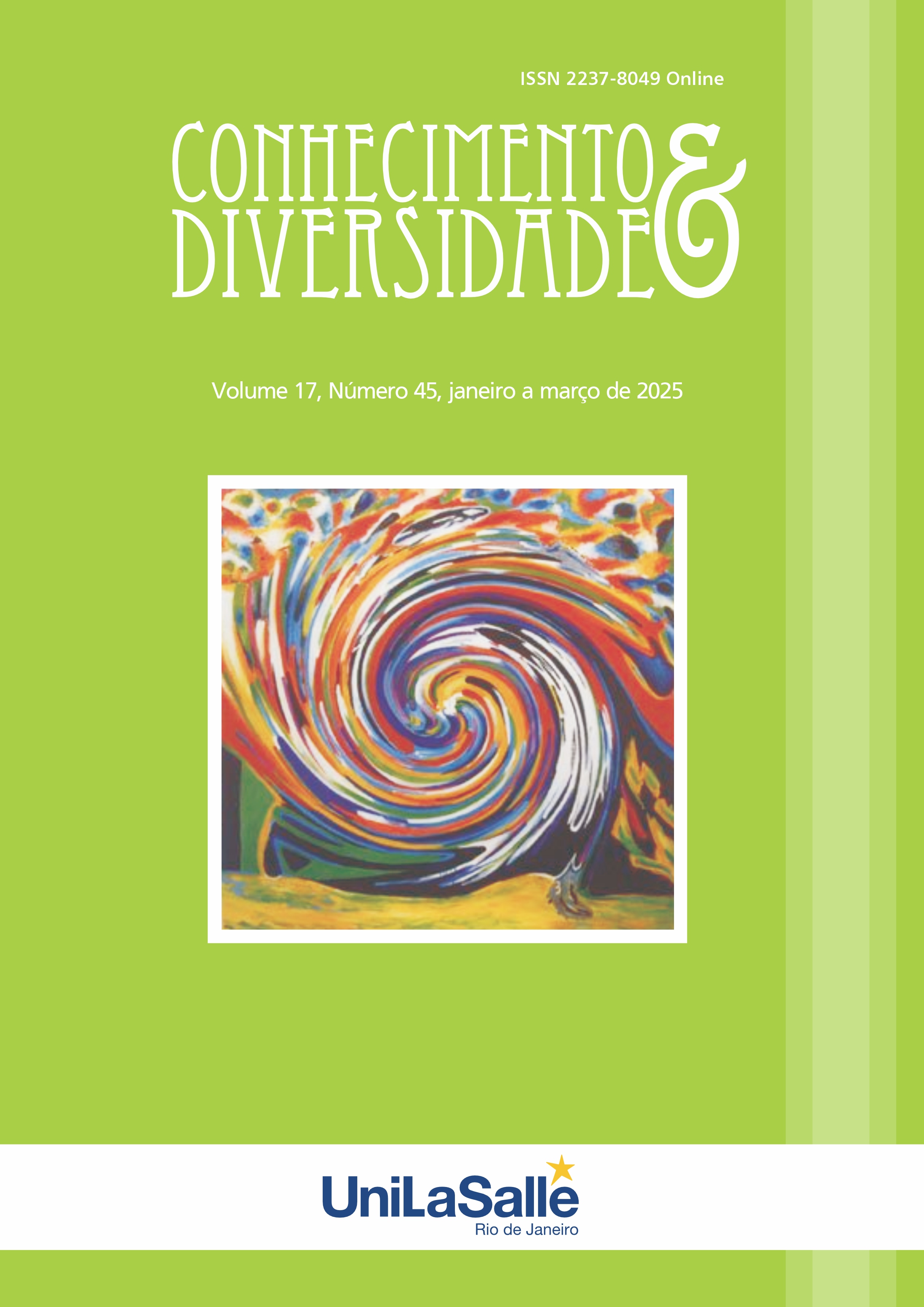COMO A DESIGUALDADE DE RENDA AFETA O SUCESSO ACADÊMICO ENTRE OS PAÍSES?
AVALIAÇÃO DOS RESULTADOS DO PISA
DOI:
https://doi.org/10.18316/rcd.v17i45.12345Palavras-chave:
Desigualdade de renda, sucesso acadêmico, resultados do PISA, comparação internacionalResumo
O objetivo do estudo é comparar se há uma diferença significativa entre as médias do exame PISA dos países com maior desigualdade de renda e dos países com menor desigualdade de renda e determinar se há uma relação significativa entre a desigualdade de renda e o sucesso no PISA. O grupo de estudo foi selecionado entre os países com a maior e a menor desigualdade de renda, de acordo com o índice GINI, usando a técnica de amostragem por contraste, que é uma técnica de amostragem intencional. Foram realizadas análises de teste T, correlação e regressão linear simples sobre a desigualdade de renda e as pontuações do PISA. As pontuações médias do PISA dos 12 países com a maior desigualdade de renda e dos 12 países com a menor desigualdade de renda foram comparadas com as pontuações médias dos mesmos países em relação à desigualdade de renda. Há uma diferença significativa entre as pontuações médias do PISA dos países com a maior e a menor desigualdade de renda. Há uma relação significativa e inversa entre a desigualdade de renda e o sucesso no PISA. Quando a desigualdade de renda aumenta, o sucesso no PISA diminui, enquanto o sucesso no PISA aumenta à medida que a desigualdade de renda diminui. De acordo com o modelo de regressão linear simples, a desigualdade de renda prevê o sucesso no PISA de forma significativa como a única variável independente. A desigualdade de renda é um fator determinante do sucesso acadêmico dos alunos.
Referências
Acham, H., Kikafunda, J.K., Malde, M.K., Oldewage-Theron, W.H., & Egal, A.A. (2012). Breakfast, midday meals and academic success in rural primary schools in Uganda: Implications for education and school health policy. Food & Nutrition Research 56(1). https://www.tandfonline.com/doi/full/10.3402/fnr.v56i0.11217#abstract
Açıkgöz, R., & Yusufoğlu, ÖŞ. (2012). The phenomenon of poverty and social repercussions in Turkey. Journal of the Human and Social Science Researches, 1(1), 76-117. https://scholar.google.com/scholar?hl=tr&as_sdt=0%2C5&q=%28A%C3%A7%C4%B1kg%C3%B6z+%26+Yusufo%C4%9Flu%2C+2012%29.+&btnG=
Aypay, A. (2022). Research design. Ankara: Nobel Publication.
Belot, M., & James, J. (2009). Healthy school meals and educational outcomes. Journal of Health Economics 30(3). https://www.sciencedirect.com/science/article/abs/pii/S0167629611000270
Boston, J. (2014). Child poverty in New Zealand: Why it matters and how it can be reduced. Educational Philosophy and Theory 46(9). https://www.tandfonline.com/doi/abs/10.1080/00131857.2014.931002
Brooks-Gunn, J., & Duncan, G. (1997). The Effects of poverty on children. Children and Poverty 7(2), 55-71. https://www.jstor.org/stable/1602387
Chiu, M.M. (2010). Effects of inequality, family and school on mathematics achievement: Country and student differences. Social Forces, 88(4), 1645–1676. https://doi.org/10.1353/sof.2010.0019
Condron, D.J. (2011). Egalitarianism and educational excellence: Compatible goals for affluent societies? Educational Researcher, 40(2), 47–55. https://doi.org/10.3102/0013189X11401021
Feinstein, L., Sabates, R., Anderson, T., Sorhaindo, A., & Hammond, C. (2006). What are the effects of education on health? https://citeseerx.ist.psu.edu/document?repid=rep1&type=pdf&doi=32e9079959269c5af50f7ad11a74712968cb01cb
GINI (2024). GINI index. https://data.worldbank.org/indicator/SI.POV.GINI?year=2023
Green, A. (2009) Education, inequality and the erosion of social cohesion. Forum 51(1), 5–8. https://eric.ed.gov/?id=EJ840434
Grossman, M. (2005) Education and non-market outcomes. Handbook of the Economics of Education 1, 577-633. https://www.sciencedirect.com/science/article/abs/pii/S1574069206010105
Gupta, R.P.-S., Wit, M.L., & McKeown, D. (2007). The Impact of poverty on the current and future health status of children. Paediatr Child Health 12(8), 667-673. https://academic.oup.com/pch/article/12/8/667/2647971
Haveman, R.H. & Wolfe, B.L. (1984) Schooling and economic well-being: the role of non-market effects. The Journal of Human Resources, 19(3), 377–407. https://www.jstor.org/stable/145879
Hill, T.D. & Jorgenson, A. (2018). Bring out Your Dead: A Study of ıncome ınequality and life expectancy in the united states, 2000–2010. Health & Place, 49, 1-6. https://www.sciencedirect.com/science/article/abs/pii/S1353829217306573
Hirsch, D. (2004) Strategies against poverty: A shared road map. New York: Joseph Rowntree Foundation. https://www.donaldhirsch.com/strategies.pdf
Horgan, G. (2009). That Child is Smart Because He’s Rich: The Impact of poverty on young children’s experiences of school. International Journal of Inclusive Education 13(4), 359-376. https://www.tandfonline.com/doi/abs/10.1080/13603110802707779
Jutz, R. (2015). The role of income inequality and social policies on income-related health inequalities in Europe. International Journal for Equity in Health,14(1). https://idp.springer.com/authorize?response_type=cookie&client_id=springerlink&redirect_uri=https%3A%2F%2Flink.springer.com%2Farticle%2F10.1186%2Fs12939-015-0247-y
Kızılgöl, Ö.A. (2012). The impact of gender inequality in education on poverty in Turkey. Journal of Management and Economics, 19(1), 179-191. https://dergipark.org.tr/en/pub/yonveek/issue/13696/165766
Marmot, M. (2004). Status syndrome. Significance, 1(4), 150–154. https://academic.oup.com/jrssig/article/1/4/150/7028894
Ministry, N.E. (2013). PISA 2012 preliminary national report. Ankara: General Directorate of Innovation and Education Technologies.
Ministry, N.E. (2015). What is PISA? http://pisa.meb.gov.tr/?page_id=18&lang=tr
OECD (2024). PISA results. https://www.oecd.org/en/about/programmes/pisa.html
Olson, M.E., Diekema, D., Elliott, B.A., & Renier, C.M. (2010). Impact of income and income inequality on infant health outcomes in the United States. Pediatrics, 126(6), 1165–1173. https://doi.org/10.1542/peds.2009-3378
Ratcliffe, C. (2015). Child poverty and adult success. https://www.urban.org/sites/default/files/publication/65766/2000369-Child-Poverty-and-Adult-Success.pdf
Redmond, G., & Kattuman, P. (2001) Employment polarisation and inequality in the UK and Hungary. Cambridge Journal of Economics, 25(4), 467–480. https://academic.oup.com/cje/article-abstract/25/4/467/1713085
Thorson, G.R., & Gearhart, S.M. (2018). The adverse effects of economic inequality on educational outcomes: An examination of PISA scores, 2000–2015. World Affairs, 181(3), 286–306. https://doi.org/10.1177/0043820018799425
Van der Berg, S. (2008). Poverty and education. Education policy series. https://citeseerx.ist.psu.edu/document?repid=rep1&type=pdf&doi=a003fb3a8192904f42a7bef31328eac3acca62ac
Wilkinson, R.G., & Pickett, K. (2010) The Spirit level: Why equality is better for everyone. Journal of Social Policy, 42(4), 840-842. doi:10.1017/S0047279413000366
Yaşar, R. (2016). The relationship between poverty, academic success and cultural capital. Kilis 7 Aralık University Social Sciences Journal, 6(2), 202-237. https://dergipark.org.tr/en/pub/kilissbd/issue/24637/260672
Downloads
Publicado
Edição
Seção
Licença
Copyright (c) 2025 İbrahim Çankaya

Este trabalho está licenciado sob uma licença Creative Commons Attribution 4.0 International License.
Conforme recomendado pelo o Public Knowledge Project, a RCD adota para seus artigos uma licença CREATIVE COMMONS: Atribuição CC BY 4.0.
Esta licença permite que outros distribuam, remixem, adaptem e construam sobre o seu trabalho, mesmo comercialmente, desde que lhe dêem crédito pela criação original.
Esta é a licença mais adequada oferecida.
Recomendado para a máxima divulgação e uso de materiais licenciados.



